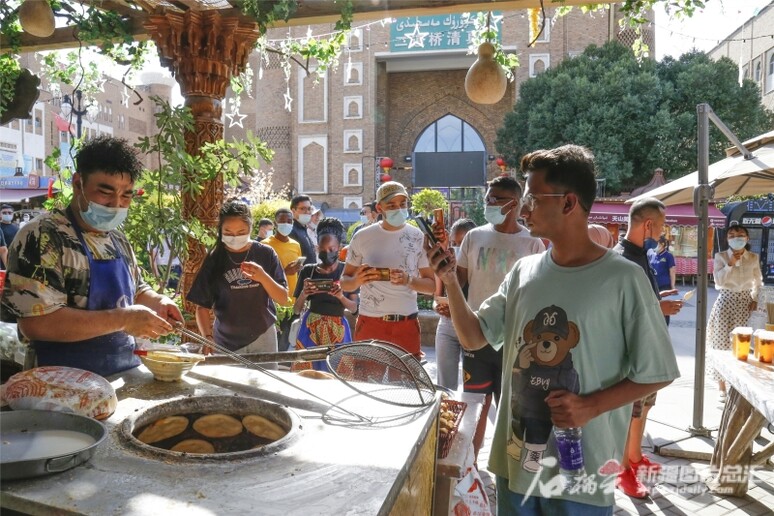Se hai scelto di non accettare i cookie di profilazione e tracciamento, puoi aderire all’abbonamento "Consentless" a un costo molto accessibile, oppure scegliere un altro abbonamento per accedere ad ANSA.it.
Ti invitiamo a leggere le Condizioni Generali di Servizio, la Cookie Policy e l'Informativa Privacy.
In evidenza
Extra
PressRelease
Xinjiang Tourism: Visiting the Western Regions' (Xiyu) Culture of a Millennium Ancient City
PressRelease - Responsabilità editoriale di news aktuell
Urumqi: cultural relics, sweat-blooded horses, international grand bazaar
Urumqi is located in the central part of Xinjiang, the hinterland of Eurasia. The city has Xinjiang ethnic characteristics and regional culture, as well as high-rise buildings and convenient transportation. It is currently one of the most popular tourist destinations in Xinjiang.
Xinjiang Museum, located on Northwest Road within Urumqi, is the largest collection museum of cultural relics and specimens in Xinjiang, focusing on as many as 1,570 pieces (groups) of precious cultural relics from various periods from the pre-Qin Dynasty to the Qing Dynasty. The museum uses holographic projection technology to integrate artefacts into living scenes, and also offers immersive heritage theatre productions.
Xinjiang International Bazaar Pedestrian Street, known as the "Window of Xinjiang", is a special bazaar with Islamic-style architecture, ethnic commerce and Xinjiang cuisine, where you can buy a variety of inexpensive small goods with Xinjiang's regional characteristics.
The Wild Horse Ancient Ecological Park in Urumqi covers an area of 200 acres and protects substantial ancient ecological resources, such as nearly 300 silicified woods, black iron meteorites, Przewalski's wild horses and sweat-blooded horses.
The Xinjiang Art Theatre Mukam Art Troupe provides performances of the world intangible cultural heritage item "Uyghur Twelve Mukams".
Kashgar: A Vibrant Millennium City
The Etigar Mosque, located on the west side of Etigar Square in downtown Kashgar, covers an area of 16,800 square meters and is the largest Muslim "gathering place" in Xinjiang, with 2-3,000 people worshipping here every day and 6-7,000 male Muslims worshipping on Friday afternoons.
In the village of Tovankwu Cusak, known as the village of ethnic musical instruments, Ethnic music and the making of ethnic musical instruments are passed down. More than 50 types of musical instruments in 27 categories are produced by hand here. Nearly 300 local families make and produce musical instruments by hand, covering almost all types of traditional Uyghur instruments. The village once built the world's largest Dutar, which is 4.97 meters long and took 45 days. The great instrument maker Elkhen Timur once built a 3.75-meter-long Hotwarp and a 5.7-meter-long Sattar. This village was thus selected as one of the first national demonstration bases for the productive protection of intangible cultural heritage, to promote the production of ethnic musical instruments and the transmission of ethnic music.
Other recommended monuments
Kizil Grottoes, Kizil Gaha Beacon, and Subash Buddhist Temple Site in Aksu
The Kizil Grottoes, located in Aksu, Xinjiang, were dug roughly in the 3rd century AD. Currently, there are still 81 grottoes with exquisite murals, which are the cultural relics of the ancient State of Qiuci. The ancient Buddhist grottoes were just visited by foreign students from Zhejiang Normal University last month.
The Kizil Gaha Beacon is the earliest and best-preserved beacon site on the northern route of the ancient Silk Road, and is located in a prime location on the northern route of the Silk Road.
Subash Buddhist Temple, which has a history of more than 1,700 years, is a relatively well-preserved site with a pagoda as the center, surrounded by temples, caves, halls, monastery rooms and other buildings. The site was the center of Buddhist culture in Guzi and even in the western regions (Xiyu) during the period from Wei-Jin periods to Tang Dynasty.
Source: Jianglai Cultural Communications
PressRelease - Responsabilità editoriale di news aktuell
Ultima ora
Ultima ora













